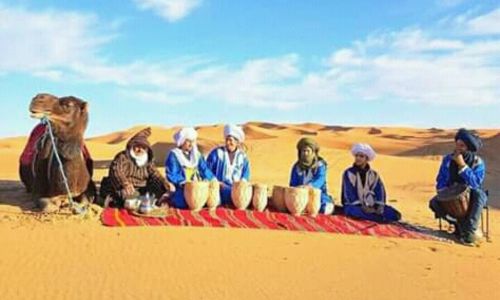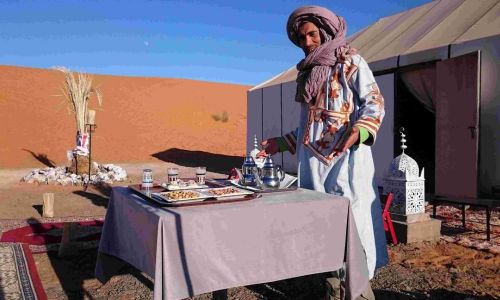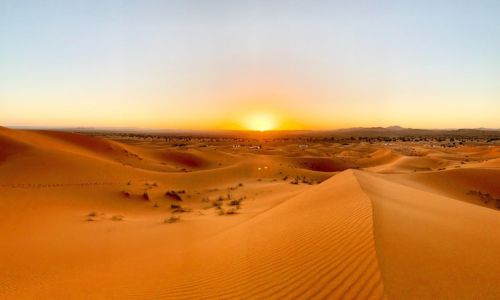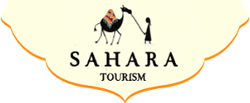Morocco camel trekking
A trip to the desert in Morocco is not complete without a Morocco camel trekking through the dunes.
For those who are fascinated by the caravans that crossed the African deserts between mythical cities carrying sought-after products like salt, this is an opportunity to feel like a nomad for a few moments.
Camel trekkings are extremely safe and easy to do and are accessible to people of all ages. Our team will always be with you on the trek to an oasis in the dunes of Erg Chebbi. As an alternative to the long camel ride, we also offer shorter rides to enjoy the sunrise or sunset in the dunes. For the full experience, come with us to the Grande Dune and sleep in a luxury Sahara desert tent.
Whatever your choice, we already have a camel for you. Your travel partner is waiting for you here in the desert, as well as a beautiful sunset! You can also try a quad ride in the desert of Merzouga. Contact us for more information or to arrange your camel trekking!
Information about a Morocco camel trekking
A Morocco camel trekking in the desert does not require any physical preparation. Children are accepted from 2 years old. Children up to 5 years of age must be accompanied by an adult during the entire trip.
Camels are highly respected by the nomads.
The attitudes of the camel and its adaptation to the desert life are often taken as an example by the nomads. As a source of inspiration, a source of income and a lifelong companion, camels are treated with dignity (and often pampered!). During excursions in the desert, the saddles are attached by straps held under the belly. The dromedary is also harnessed with a strap at the level of the lower jaw (or nostril), in order to allow the advancement of the caravan.
The camels of Morocco
The ancestor of the dromedary would have appeared 50 million years ago and would have entered Africa, there are 2 to 3 million years.
The dromedary was domesticated between 2000 and 3000 years BC.
Its massive use (transport camel) dates back to about 1500 years.
The dromedary belongs to the family Camelidae, genus Camelus, in which we find 2 species:
Camelus dromedarius (one-humped dromedary). Animal of the hot deserts of Africa, the Near and Middle East.
Camelus bactrianus – Bactrian camel – (dromedary with two humps). Animal of the cold deserts of Central Asia to Manchuria.
Called a dromedary: a camel, is not incorrect but not very accurate.
The female of the dromedary is “the camel” and the young “the camel”. We will speak here only of the dromedary Camelus dromedarius, 1 hump. 80% of the world’s dromedary herd is present in Africa: mainly in Somalia, Sudan and Ethiopia.
The desert camel in Morocco
The dromedary is a tylopod, digitigrade, herbivorous and ruminant (it has 3 stomach pouches). Its main food is the desert vegetation. It can also feed on dried dates, wheat (during the dry season) and, in the case of breeding, different cereals.
In the “cool” season the dromedary can stay 10 to 15 days without drinking. During the dry and hot season, it can stay 1 week without drinking. Following an intense dehydration, it can drink up to 100 L of water in less than 10 minutes).
Its average height is 2 m to 2.50 m at the withers, with a weight between 400 and 1100 kg.
The male is generally taller and stronger than the female camel.
The life expectancy of the dromedary can reach about forty years. However, a deficiency of the teeth generally limits this life expectancy to 20 or 25 years.
The examination of its dentition allows to know its vitality and to estimate its life expectancy.
The reproduction period varies according to the environmental conditions (food, water in sufficient quantity, outside temperature…). Gestation lasts on average 13 months.
The male is put to the reproduction around the age of 6 years, while the female can be put to the reproduction around 4 years. Over a lifetime, a camel can give birth 7 to 8 times.
A dromedary can walk about 100 km per day, without load; 40 to 50 km per day, with a maximum load on the back of 200 kg. Its average speed, depending on the load, is about 4 to 5 km/h.
The dromedary blatters. It emits sounds to protect itself (in particular to indicate to its congeners to stay away).
It emits a low, roaring sound, with trembling lips, during the rutting period. During this period, the dromedary can change its character, drool, tremble, have diarrhea and become more aggressive.
In Morocco, there are about 190 000 heads (all breeding combined). There are no wild dromedaries.
There are 2 types of dromedaries which are characterized by the color of the coat (from brown/red to white/sand), the tribal origin, the place of life, the size:
the mountain dromedary, known as “Jeblli”. Small and slender, with an average height at the hump of 1.85m. The camel gives little milk and is practically not milked.
the dromedary of the plains, called “Sahraoui”, mainly present in the desert, taller and more robust, with an average hump height of 2m. The camel gives milk in good quantity and fattens more quickly. This Sahraoui type is subdivided into 3 “sub-categories”, even if it is not easy to recognize them: the Guerzni, the Marmouni and the Khouari.
The dromedary, an animal of the desert environments par excellence.
The dromedary of the desert in Morocco
The dromedary is an animal perfectly adapted to the life of the desert. The nomads are inspired by it for their own adaptation to these difficult conditions. The body of the dromedary is, in every way, adapted to the long walks in the desert and to the great heat. Their characters also adapt to the hard life of the Sahara. They can be grumpy but are very often patient and calm.
In this animal, there are physiological processes of water saving which are carried out by the respiratory, digestive, cutaneous, renal ways. Its corpulence, its internal temperature, its head carriage, its long limbs…. everything is adapted to the heat of the Sahara and to the lack of water (cf. the thesis of Caroline DRIOT quoted in bibliographic reference):
Their sinuses are deep and have a “bag” that allows water to be collected when exhaling through the nasal passages. Dromedaries have the ability to close their nostrils completely, which greatly reduces the drying of the nasal mucosa and prevents sand from entering.
The cilia have 2 rows of hair to protect the eyes from sand and wind.
Sweating in the dromedary is very low because of the low number of sweat glands, which limits water loss.
The dromedary’s fat is mainly found in its “hump”. This reserve allows the camel to travel long distances without eating or drinking.
The limbs are long and keep the body and vital organs away from the ground and heat. Very rough areas are also present on the knees and on the sternum to protect the animal from heat when lying down.
Unlike most animal species, heat and dehydration weaken the activity of the thyroid gland causing a slowing of the overall metabolism.
The dromedary can lose up to 30% of its weight in water, without endangering itself (against 12% for other species).
Its body temperature varies from 36°C to 42°C, depending on the outside temperature and its hydration.
The volume of urine is also adapted to the dehydration of the dromedary and can reach 0.1% of its weight. The elimination of a very concentrated urine explains the tolerance of the dromedary to salts (present in many plants of the Sahara) and to the ingestion of brackish water.
The volume of saliva production is also strongly influenced by water deprivation.
The dromedary emits the driest excrement of all domestic ruminants: a very large part of the water is reabsorbed by the small intestine. The desert camel in Morocco
The usefulness of the dromedary in Morocco – Camel breeding
The desert camel in Morocco
In southern Morocco, the camel is an essential component of the economic life of certain populations and is the social basis of the Sahrawi tribes. Indeed, extensive pastoral breeding is one of the main sources of income for the inhabitants of the south and the possession of dromedaries represents “a heritage”, source of pride and marriage dowry.
The dromedary is used for its milk, meat and hair, but also for sport, or as a saddle animal. It is commonly used as a pack animal (portage).
It is no longer used as a mode of transport as it was in the past.
The common uses of the dromedary in Morocco :
Milk: The milk production of a camel depends on the breeding method. It varies from 2 to 6 liters per day in the open air (consumption mainly raw by the families and the tribe. Butter or cheese made from camel milk is very difficult to produce); and 12 to 20 liters in intensive breeding. Dromedary milk, with its high vitamin C content, has many virtues on diabetes, cancer, chronic hepatitis and allergies. Moreover, the fat of camel milk is highly digestible.
Meat: Dromedary meat is mainly consumed for special occasions, especially for big weddings. It remains a source of quality protein: it is a lean meat, rich in water and protein.
Urine: traditionally, dromedary urine (especially the urine of the camel at the beginning of gestation) is given therapeutic properties. It is one of the ingredients of the traditional pharmacopoeia in southern Morocco. Many medicinal virtues have been observed for the treatment of skin diseases, pain in the abdomen, blood purification…
The wool: The wool of the chamelon is smooth and more easily spun than that of adults. These wools are useful for clothes, blankets, carpets and tents in the Moroccan south.
Leather: The skin is used for saddles and thongs.
Agricultural work: (very little, in northern Morocco) often associated with hair or donkeys.
Dromedary races during festivals, during training…
Dromedaries for saddling and/or carrying (traveler’s hike, trek and meharee with carrying of the bivouac’s stuff ….)
Two types of camel breeding in Morocco:
The extensive pastoral breeding is the most widespread. It corresponds to the movements of the herds in search of the best pastures near water points. (example in the Drâa valley, around Mhamid). The great nomadism (permanent displacement of herds over great distances) remains little developed.
Semi-intensive breeding is concentrated around the medium and large towns of southern Morocco and gives rise to the creation of “dairy cooperatives” which tend to grow to meet the growing demand for camel milk.
Dromedary breeding is difficult, but tends to increase. The main difficulties are the feeding, for extensive breeding, which varies according to the climatic conditions. In addition, parasites, infant diarrhea and skin diseases are numerous.
Trypanosomiasis is the most frequent disease (transmitted by horseflies), which can lead to great weakness and, more rarely, to the death of the dromedary. Other diseases affect the herds such as scabies or smallpox.
These can quickly decimate camel populations and cause significant “economic losses”.
In the desert (less affected by major diseases), the long droughts and the arrival of the Doubab (dromedary hippobos/spider fly) are sources of stress and constraints for the owners of dromedaries.
The desert camel in Morocco
Morocco has put in place a dynamic agricultural policy (the Green Morocco Plan), favoring, in particular, the development of dromedary herds. On a sanitary level, this involves: raising awareness of breeders about dromedary diseases; quarantining new arrivals in the herds; setting up a veterinary support and monitoring; providing free medicines; creating subsidies dedicated to the caravan.
Information
Any doubt? Contact us, we will kindly help you with any need.
DISCOVER OUR TOURS TO SAHARA DESERT IN MOROCCO

FROM MARRAKECH
Our most popular Morocco Sahara Tours . The trip from Marrakech is rich in scenery and includes an unforgettable stay in a Desert Camp.

FROM FES
A great experience starting from Fes including camel trekking and at least one night in a tented desert camp in the Merzouga Desert.

CUSTOM TOURS
Our experts can create exceptional tailor-made experiences for our clients. Contact us and we´ll plan your perfect trip in Morocco.
